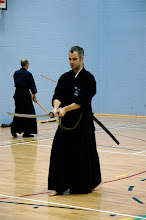I was once told during a written examination of iaido in Japan, that the four "columns" of iaido consisted usually of nukitsu, kiritsuke, chiburi and noto. Every kata, more or less, contained all of these elements. Each possesses an essential quality of its own:
- Nukitsuke would be expressed by a range of strategies including taking the enemy by surprise, seizing the moment, controlling or suppressing their attack etc.
- Kiritsuke* would be expressed as a decisive termination of the enemy's life once the exponent had decided that this was the only solution.
- Chuburi would be an expression of zanshin once the distinct fighting part of the kata is over to release the body and unseize the mind.
- Noto additionally would be an expression of zanshin, almost the complete reverse of nukitsuke, but being uber aware during this dangerous moment of the sword being resheathed thus being a moment at which the exponent was most vulnerable to an additional attack.
*For those kata that are concluded with a thrust, this element would be called Tsukizuke which is both difficult to pronounce without spitting and is a homophone of "moon pickles".
Despite each of these elements being self-evidently vital, I sometimes (often) notice the tendency for noto to be given a slightly lower position on the priority ladder. It seems that once all the sword waving and posing for the camera had been completed, noto was a fiddly detail that one had to get through in order to progress to the next kata.
Given the number of minor injuries that I and others had suffered while doing noto, this feels like a wasted moment if not given the same priorities as the other elements in the kata. I mean, just because the letter "Z" is at the arse end of the alphabet, it doesn't make it less important - ask any Polish person!
To illustrate this vital point, here is a list of the names of some my closest Polish friends with the Z's in their names caps'd and in bold.
- LukasZ Machura
- Michał SZcZepański
- Paweł BrZeZiński
- AgniesZka KrawcZyk
- Marcin Zyga
- Ziemowit ZenZiZenZiZenZic (shortened to "Domański")
Most of them have more Z's in their name than vowels! Some has more Z' than letters!
Back to the story...
During 2024 and 2025 I spent some considerable time in Japan training at Shinbukan while students of our dojo prepared to take 6th and 7th dan exams in iaido and jodo. It just so happened during one of these visits, while coaching a 6th dan iaido candidate who had just been landed with her brand new shinken, that Ishido Sensei explained in detail the method of doing horizontal noto i.e. that used in Muso Shinden Ryu and other ryuha.
While I had picked up snippets of this methodology over the years, this was the first time to have it explained in such comprehensive and complete detail. Additionally, Ishido Sensei over the last year during my visits was very focused on the correctness and general performance of noto.
He showed me a scratchy old black-and-white video of some very old iaido masters (who were also scratchy and black-and-white) doing demonstrations and at one point, emphasised how, despite age affecting their speed and power in nukitsuke, kiritsuke and chiburi, their noto still contained the essential aspects of speed, fluidity, control and zanshin vital for a well performed noto. He told me that while most people could learn speed and power within a few years, true quality from decades of practice becomes visible in the way noto is performed.
And so he instructed very clearly and in detail, the exact movements of preparing for noto which I will try to present now. Please bear in mind that this is Ishido Sensei's version of Muso Shinden Ryu noto; other styles may have other methods, even other lines of MSR might vary.
I will first explain my understanding of his noto method up to that point and then explain why it doesn't work so well. Previously I had gripped the koiguchi in a natural way and then rotated the saya (that is the angle of the koiguchi to about 45°. Then as the sword approached the left hand I would rotate the saya to the full 90° to align the hasuji of the saya with that of the sword. I wasn't sure why it should be rotate to a 45° waiting position first, I just did it as I had been taught this way by Ishido Sensei.
 |
| How most people grip prior to noto |
You can see from the movie and images below that what this creates is a fairly unnatural bend in the wrist once the saya is rotated to 90° and as sayabiki is performed. This bend in the wrist can make sayabiki difficult especially if one's obi is too tight.
 |
| The effect on the left wrist from such grip |
 |
| The crooked left wrist effect as sayabiki is performed |
Instead, Sensei instructed us to distinctly grip the saya from above and pinch the tips of the forefinger and thumb together. This pinch-point had to be located at the bottom of the koiguchi.
 |
| Correctly gripping the saya from above with forefinger and thumb pinched together |
Conversely this would put the wrist in a slightly awkward position and so the next move would be to rotate the koiguchi to 45° - finally a reason for taking this position!
 |
| Rotating the koiguchi to 45° and straightening the wrist |
The effect of positioning the forefinger and thumb tip together at the bottom of the koiguchi is to broaden the "platform" on which the sword sits while doing the outward-moving action of noto. This is particularly important if using a shinken where stability is all too important.
 |
| Rotating the koiguchi to 90° and making a broad "platform" to place the sword on |
Finally the noto takes place; you can see that the left wrist is slightly crooked but is considerably straighter than the original shown at the top.
 | |
| Comparison of wrist angles (left: original at about 45°, right: optimised at about 30°) |
This allows a stronger sayabiki during noto and keeps the platform on which the sword is resting much more consistently horizontal and broader. The result of this can be seen below.
.gif) |
| "Enhanced" noto |
Sensei also emphasised that it was important not to get "busy" during noto; this was meant to be the purest expression of zanshin and so if too many actions were being done at the same time than the mind would become distracted. Instead, as the saya is gripped and initially rotated, the right hand should not be moving; there should then be a brief pause, a sign of readiness. Depending on the class of kata being done, the right hand would then move towards the left hand which would move either at the point of contact in the centre of the body (as per "seitei" noto) or would start moving just before the sword reached it (different depending on whether one was doing shoden, chuden or okuden). The main point was that regardless of how fast and flashy one wishes their noto to be, it shouldn't become busy or scruffy with unnecessary movements and poor coordination.
Given that my own shinken is sharp enough to confuse a leprechaun and that I really like my saya, I have tried to maintain this tone of noto since receiving this shinken back in 2018. It has slowed my noto down but I think I prefer this method instead of it just being rushed. The lack of splinters falling out of the saya during cleaning is a good thing and so is being able to type with all my fingers in place. Noto need not be light-hearted and simply flashy; there's more to it than that.













